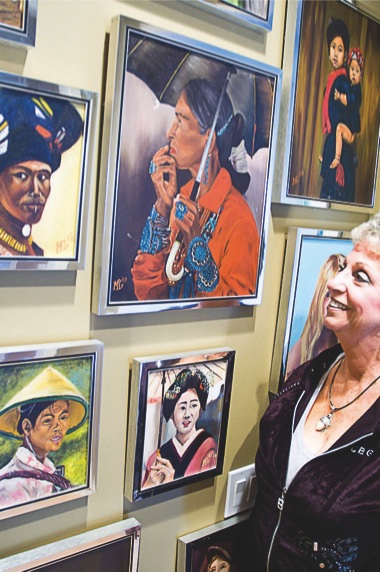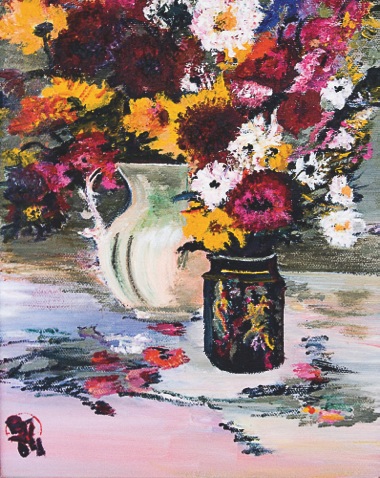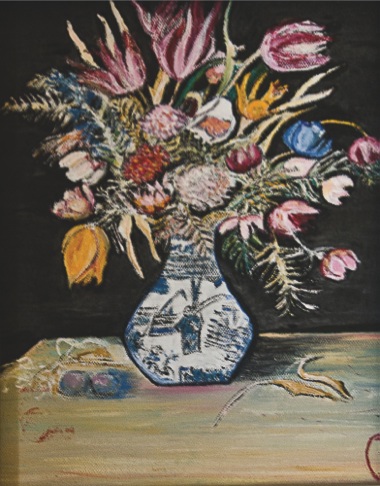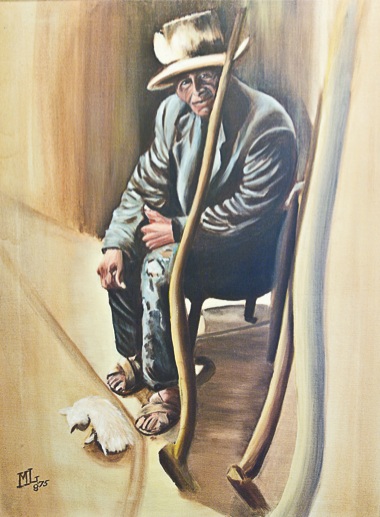Like father…
Artwork is a regular feature in Neighborhood 24 resident Bobbi Vinton’s home, but one wall in particular displays a collection that means more to Vinton than what an appraiser’s price tag might read because how does one appraise the work of his or her father?

A penchant for painting and art wasn’t just a talent than ran in Bobbi Vinton’s family. It was the bond between her and her artist father, who painted the collection featured above. (Photo by Chris LaPelusa/Sun Day)
Vinton’s father may not have made a living from his paintings. He may not have been famous or had his name in lights, but he was no less a master for the lack of public recognition. Maybe because Vinton, his daughter, was his biggest fan.
“I was always really close to my father. I was so much more like him,” Vinton said.
As far back as Vinton remembers, her father (98) was sketching or painting.
“He started in photography and was developing his own photography. That led him into chalk drawings and [other mediums],” Vinton said.
Vinton explained that her father practiced most mediums, such as chalk, oil, pencil, water, and acrylic.
Vinton said her father delved into his artwork heavily after her mother died young at 58. Her father was 60.
“To fill his time, he [my father] started taking lessons in other mediums,” Vinton said.

Although different from her father’s work, Vinton said her father helped develop her skills as an artist. Bobbi Vinton’s work featured here.
It was at this time that Vinton’s father acquired the signature look you see in his paintings in Vinton’s home, when he learned a technique called turpentine wash.
“It’s so realistic looking,” Vinton said. “You see all the lines on faces.”
Vinton said painting was a hobby for her father, one he practiced until he was 85.
Now at almost 99, Vinton’s father hasn’t picked up a brush in nearly 14 years, mostly due to his dementia.
Vinton explained, “It wasn’t that he lost his ability to [paint]; he lost his patience to sit there.”
Vinton said her father could draw anything and described him as one of extremely high intellect, a successful businessman, and very musically inclined.
“He was multitalented,” Vinton said. “Really a unique guy.”
…Like daughter
“Everything my father did, I wanted to emulate,” Vinton said.

Despite that Vinton’s father no longer paints, his work lives on not only Vinton’s home and in his family but with Vinton herself, who also has the “art gene.”
Vinton started painting at four years old, first picking up a brush when her father gave her a paint-by-numbers set.
“I was able to stay in the lines,” Vinton said, “which is really amazing because at that age you don’t have small muscle coordination.”
It wasn’t long before Vinton graduated from paint-by-numbers to real painting and drawing with the guidance and instruction of her father.
From then on, Vinton was hooked. She fostered her skills as an artist and often throughout her life considered the practice of painting cathartic, a place to carry herself away.

“It was like my Nirvana. When things were really getting [harried], I’d go into my studio and say, ‘Okay, it’s time to escape,’” Vinton said. “I really like the alone time. When you’re doing a painting, because you’re working on it on and off, and after a while, because you’re doing it so often and in spurts, you become intimate with your painting. You get to know every line and every crack and every little [detail].”
Vinton did joke, however, about the disappointment or pleasure an artist so often feels upon first looking at his or her most recent progress after a few days not seeing it.
“Perspective is not there until you come back after a while,” she said. “But while you’re in it, there’s an intimacy that goes on with you and the painting. You’re just so absorbed in creating what you want it to look like.”
Although Vinton said her work and her father’s work are nothing alike, even stating that her father’s work “is just better,” their mutual hobby was a bond they shared.
“It was a way to connect to him,” Vinton said. “We could communicate with each other without a lot of talking. Now that I have his painting hanging [in my home], it just thrills him that I was the one who took them and put them in a category that’s meaningful.”




